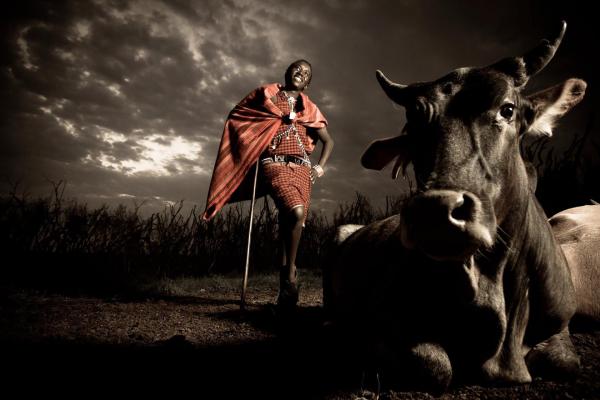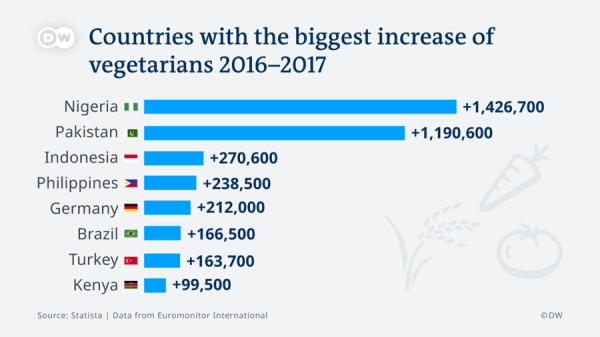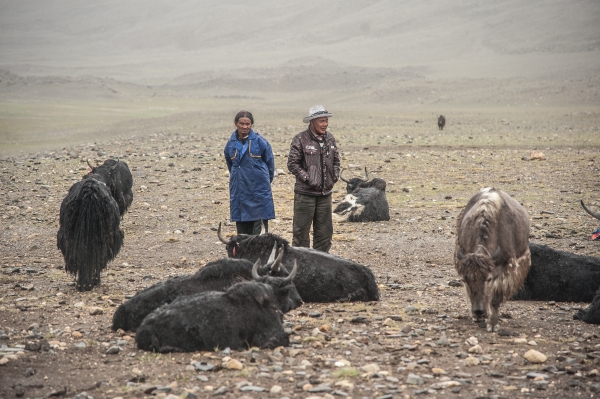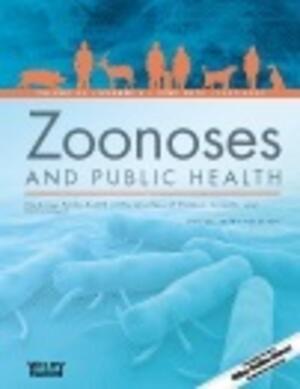
Thursday Links (September 2019)
A monthly round-up of recent articles, blog postings and tweets about livestock, aid and other topics that may be of interest to International Livestock Research Institute (ILRI) staff and partners, compiled by David Aronson.
News out of Africa
An article in The Nation says that supermarkets in nine Kenyan counties tested still stock and sell meat contaminated with sodium metabisulphite, a banned preservative.

Photo of Pokot woman and cattle in northern Kenya, courtesy Cultural Survival, by Stuart Butler
For women pastoralists—livestock farmers in the semi-arid lands of Kenya—climate change has forced drastic changes to everyday life, says this article in South South News.
Uganda’s Emma Naluyima, a smallholder farmer and trained veterinarian, and Senegalese forestry engineer Baba Dioum were this week named joint winners of the 2019 Africa Food Prize, a USD 100,000 award celebrating those taking control of the continent’s agricultural agenda. For more on the two laureates, see here.
Niger is growing increasingly angry at incursions of cattle thieves from Mali (in French).
The construction in Ethiopia of some water spreading weirs—structures that spread floodwater over the width of a valley—have encouraged some pastoralists to take up farming.
Climate change is already deeply affecting Somaliland’s pastoralists. A short film from Thomson Reuters shows how.
Nigeria is launching a livestock transformation plan to reduce farmer-herder violence in northern Nigeria over grazing rights.
An article in the Daily Nation says that some pastoralists in northern Kenya have nowhere to move to in search of pastures and water since most of the land where they grazed their stock during dry periods has been taken over by conservancies.
A camel herder in Niamey, Niger, is making USD 3,000 a day selling camel milk, reports the BBC. A broader overview on the rise of ‘white gold’ alt-milks can be found here.
A new book explores South Africans’ love of cattle—and asks whether that love can be justified in a period of accelerating climate change.
Satellite images show large areas of barren pastures blanketing much of Senegal and Mauritania—which means animals will die, stripping owners and their families of their sole source of food and income. Hundreds of thousands of people may be at risk of hunger. But in wealthier, urban areas of Senegal, the wealthy are paying a fortune for fancy sheep to impress their neighbours.
An overview of the political risk landscape in sub-Saharan Africa, from the World Economic Forum: ‘In addition to rising geopolitical and geo-economic frictions, the effects of climate change are becoming dangerously pronounced.’
Alt-meats, vegetarianism and the future of livestock
A New York Times editorialist has penned a passionate defence of vegans and vegetarians: ‘We need more vegan voices, because on the big issues — the criminal cruelty of industrial farming; the sentience and emotional depth of food animals; the environmental toll of meat and the unsustainability of its global rise — vegans are irrefutably on the right side of history’.

A KFC in Atlanta trialing ‘meatless’ fried chicken sold out in less than five hours.
Kentucky Fried Chicken is getting rapturous reviews for its Beyond Meat fried chicken, which in its Atlanta trial sold out a 90-day supply in less than five hours last month, with lines “wrapped around the restaurant” from the moment the store opened.
However, at least one financial analyst thinks the plant-based meat industry has a smaller potential than the market projects—and has downgraded his recommendation of Beyond Meat, one of the leading alt-meat firms and KFC supplier, to a ‘sell’.
Cambridge University’s catering service has replaced meat with plant-based products for its 14 outlets and 1,500 annual events.
This is a long, thoughtful article on whether the ‘eat less meat’ advocates get the science wrong, written by a food journalist and the author of a cookbook on grassfed beef: ‘Farming advocates see livestock not as the great climate polluters, but as essential tools in a functioning agroecological system—ones that provide a highly nutritious, saleable food product.’ A similar article in South Africa’s Business Day makes the case that ‘it’s not so much about what we farm. It’s about how and where’.

Courtesy: Euromonitor
According to the Euromonitor, the number of people abstaining from meat is growing—and mostly in countries that might surprise you:
A video of a British tourist harassing a chicken seller in Morocco for keeping chickens in a cage has sparked outrage and received more than 12 million hits.
A survey of (American) millennials finds that 60% are aware of the environmental consequences of their dietary choices and are trying to incorporate more plant-based food in their diet.
The Guardian’s George Monbiot has written frequently about the environmental perils of livestock. This op-ed, published in The Guardian, suggests he’s got his facts wrong.
International reports
Two major international reports were released in the past month. The International Panel on Climate Change (IPCC) has released the third of its four major reports on climate change here, to a wide variety of reactions and interpretations. And a report from the Global Commission on Adaptation, headed by Bill Gates, Ban Ki Moon and Kristalina Georgieva, says that we need to ‘invest in a massive effort to adapt to conditions that are now inevitable: higher temperatures, rising seas, fiercer storms, more unpredictable rainfall, and more acidic oceans’.
Several studies of digitization and data in smallholder Africa were also released this month. Is Africa’s agricultural sector ready for its digital moonshot? The World Bank asks whether, in the face of climate change and growing population, disruptive agriculture technologies (D4Ag) can be a catalyst to transform agriculture and solve the multiple challenges facing SSA farmers today. USAID and Feed the Future also have a report out on the importance of data-driven agriculture for smallholders worldwide. And the Malabo Montpellier Panel’s report—’Byte by Byte: Policy Innovation for Transforming Africa’s Food System with Digital Technologies’—summarizes what seven African countries at the forefront of progress on digitalization of the agriculture sector have done right.
Communication for scientists
 An interesting article in Nature on how to use art—and graphics, specifically—to increase research impact. Note the graphic on the spread of small farms worldwide.
An interesting article in Nature on how to use art—and graphics, specifically—to increase research impact. Note the graphic on the spread of small farms worldwide.
This is an exceptionally clever use of graphics: 14 little coffins of potato diseases, courtesy of the Canadian Potato Museum.
Women & livelihoods in livestock
BRAC, a Bangladeshi anti-poverty program that gave the ultra-poor (mostly women) a cow, some husbandry training, and a few lentils and start-up cash, is having an enviable problem—it’s running itself out of business as the country grows too rich.
A new World Bank metric, the Human Capital Index (HCI), measures the likelihood of people living in different countries to live up to their potential. Kenya fares well compared to its African peers.
China could release emergency pork reserves after losing 100 million pigs to swine fever. CNN Hong Kong reports that African swine fever has wiped out a third of China’s pig population.
Nutrition and AMR
For decades, the American public was warned about the danger of too much animal-source fat in their diet. Then came evidence that sugar, not meat, was the real culprit behind America’s obesity epidemic. Articles in some of the country’s leading news journals, including the New Yorker and the New York Times, intimated that there might have been a well-funded ‘sugar conspiracy’ to shift blame away from sugar and onto dietary fat. But this article argues that the shift in focus represents nothing more than science in action—driven less by fraud or personal corruption than by the exigencies of industrial funding.
The British Medical Journal has published a report saying that people who eat vegan and vegetarian diets have a lower risk of heart disease and a higher risk of stroke. A BBC write-up of that research is here; and a Kenyan version from the Daily Nation is available here.
This article in a peer-reviewed Food Science and Nutrition says that ‘claims about the health dangers of red meat are not only improbable in the light of our evolutionary history, they are far from being supported by robust scientific evidence’. But this article in Popular Science says that swapping meat for ‘pretty much anything else’ can increase your lifespan and be good for your health.
A claim disseminated widely in the press, that nearly half child deaths in Africa stem from hunger, appears to have been a deliberate misread of a 2013 study that referred to neither Africa nor hunger.
Gene-editing cattle through CRISPR technology is turning out to be a more complex effort than originally thought. During a recent data run, the US Food and Drug Administration (FDA) found foreign, non-bovine DNA that had bound itself to the animal’s genetic sequence during the edits—causing some animal scientists to call for a pause in the use of the procedures.
Climate change, food security
The Economist points out that the countries most exposed to climate change face higher costs of capital: ‘By 2030 poor countries will need to spend $140bn-300bn each year on adaptive measures, such as coastal defences, if they want to avoid the harm caused by climate change’.
An article in Foreign Policy magazine claims that cutting beef consumption could liberate almost 11 million square miles of land—the size of the United States, Canada, and China combined; and that the land use change required to produce a single kilogram of beef protein is equal to emitting 1,250kg of CO2, the equivalent of driving a car 24/7 for a whole year, or flying from London to New York and back. It concludes: ‘We’ve ended the sale of whale and shark fin for environmental reasons… why not beef?’

Photo of Changpa pastoral nomads – at a high altitude pasture in Ladakh’s Hanle Valley. From Ritayan Mukherjee/PARI
Mongolian yak herders are adapting discarded Soviet-era cooperatives for their own survival. But this article says that Himalayan yaks in northeast India are dying of starvation, possibly because of climate change.
Is the global food system in danger of collapse? An article in Time magazine says that ‘disruptions in supply are already evident almost everywhere food is grown’.
An article in Nature says that the world’s top half percent—or 42 million people—are responsible for more greenhouse gas emissions than the poorest half of the global population —3.8 billion people.
Misc
A food archaeologist makes the case for his discipline: ‘From stone tools and ceramic containers to animal bones and carbonized seeds, food trash is abundant at most archaeological sites. What’s more, the archaeology of ancient food doesn’t just tell us more about how people lived in the past — it can help us plan for an increasingly scary future’. Relatedly—scientists have discovered evidence of the earliest known consumption of cow milk by humans—in the dental plaque of prehistoric farmers some 6,000 years ago in Britain.
Human Rights Watch has issued a report condemning safety conditions at US meat processing facilities.
ISIS is rigging cows with explosive devices—in effect, weaponizing cattle, by turning them into unwitting ‘suicide bombers’.
Omani camel racers train their beasts by having their camels swim in the Sea of Arabia. Can a camel triathlon be far behind?
And now another in our recurring series: Goats, what can’t they do?
Portugal has a wildfire problem—and it has enlisted some 11,000 goats in a pilot program to help reduce the overgrowth that fuels forest fires. And in the Washington Post, an article on how goats are the ‘new weedwackers.’
Maurice the Rooster, the famous French cock whose plight was featured in the July issue of Thursday Links, can continue to crow, says a French court.
Your word of the day: ALEKTOROPHOBIA is the fear of chickens.




















